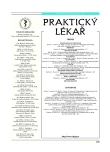Antibiotics and their application in pregnancy
Antibiotika a jejich užití v těhotenství
Práce shrnuje současný stav znalostí o možném negativním vlivu léků užívaných pro léčbu infekčních onemocnění na vývoj plodu a doporučuje léčbu s nejmenším rizikem. Upozorňuje na ostatní faktory, které je třeba brát v úvahu při hodnocení rizika. Zdůrazňuje nutnost jeho posouzení v závislosti na farmakodynamickém působení, které se u různých léků liší; některé léky nejsou vhodné v 1. trimestru, jiné až perinatálně. Pro léčbu těhotných a žen v reprodukčním věku se doporučují již prověřené léky. V každém případě je však třeba infekci léčit. Neléčená infekce je větším rizikem než vhodná léčba. Antibiotika je třeba volit podle citlivosti infekčního agens a znalostí o jejich riziku v těhotenství (nejvhodnější jsou peniciliny a cefalosporiny). Kombinace léků nejsou vhodné. Hrozí potenciace nežádoucích účinků.
Klíčová slova:
těhotenství – infekce – antibiotika.
Authors:
E. Maňáková
Authors‘ workplace:
Česká teratologická informační služba, CBO – oddělení histologie
a embryologie, 3. LF UK, Praha
vedoucí prof. MUDr. R. Jelínek, DrSc.
Published in:
Prakt. Lék. 2005; 85(8): 454-456
Category:
Therapy
Overview
The review summarizes present knowledge on the possible negative influence of anti-infectious drugs on prenatal development and recommends therapy with minimal risk. It alerts on other factors that are to be considered, too. The risk need be evaluated with regard to the pharmaco-dynamic effect, which varies in different drugs. Some of them are inappropriate in 1st trimester, other only perinatally. Only time-tested drugs are appropriate for therapy in pregnancy or better, for all women of reproductive age. Treatment of infection is absolutely essential. Untreated disease represents a higher risk than appropriate treatment. Antibiotics should be selected according to the known sensitivity of the infectious agens and knowledge on their safety in pregnancy (penicillins and cephalosporins are the most appropriate). We should avoid drug combination, because adverse effects may be potentiated.
Key words:
pregnancy – infectious diseases – antibiotics.
Labels
General practitioner for children and adolescents General practitioner for adultsArticle was published in
General Practitioner

2005 Issue 8
- Memantine in Dementia Therapy – Current Findings and Possible Future Applications
- Memantine Eases Daily Life for Patients and Caregivers
- What Effect Can Be Expected from Limosilactobacillus reuteri in Mucositis and Peri-Implantitis?
- Metamizole at a Glance and in Practice – Effective Non-Opioid Analgesic for All Ages
Most read in this issue
- Bacterial immunomodulators
- Antibiotics and their application in pregnancy
- Diagnosis and therapy of tracheal stenosis
- Type A aortic dissection, case reports
